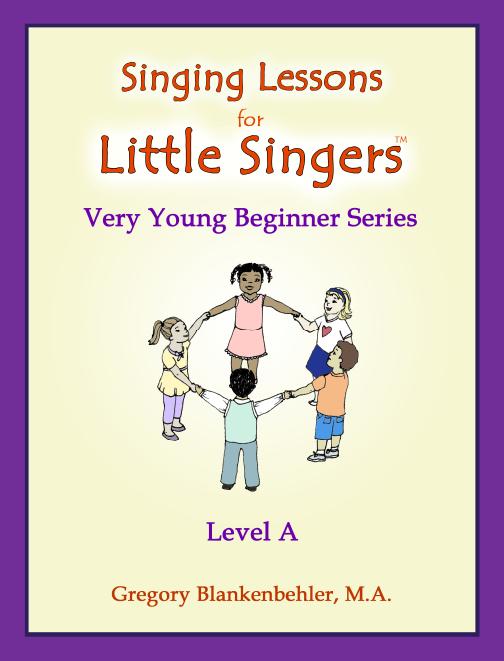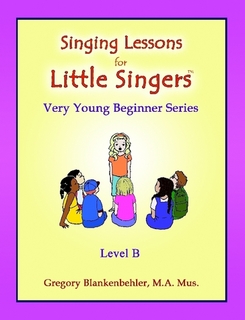Finally, a substantial singing method for the youngest little singers!
 Why is it that piano and violin students can start learning technique, sight reading and music theory in their kindergarten years, but young children interested in singing are deemed incapable of anything more than sing-along choruses? Who decided that young voice students weren’t capable of real musicianship study, and didn’t need the documented cognitive benefits that come from it? Singing Lessons for Little SingersTM is proud to present, at last, a singing method that combines real vocal and musical training with fun songs and activities that will make your little singers think they are just playing games.
Why is it that piano and violin students can start learning technique, sight reading and music theory in their kindergarten years, but young children interested in singing are deemed incapable of anything more than sing-along choruses? Who decided that young voice students weren’t capable of real musicianship study, and didn’t need the documented cognitive benefits that come from it? Singing Lessons for Little SingersTM is proud to present, at last, a singing method that combines real vocal and musical training with fun songs and activities that will make your little singers think they are just playing games.
The “Very Young Beginners” series is tailor-made for children ages 4 to 7 from current research and practical experience. In three progressive levels, it teaches professional singing techniques and total musicianship skills:
|
|
|
Level A
Level A is the most basic level of Singing Lessons for Little SingersTM and is designed to give young singers of preschool and early elementary age (or older, as needed) a solid foundation in the fundamentals of singing and musicianship.
- Technique: Age-appropriate introduction to “belly breathing” and sustained supported singing; Basic pitch “placement”; Properly singing in both the “low” and “high” voices.
- Ear Training: A progressive approach beginning with high/low, up/down slides; Interval training using the pentatonic scale beginning with the minor 3rd (sol-mi) and adding the major 3rd (mi-do), major 2nd (sol-la), minor 2nd (mi-fa), perfect 4th (mi-la) and 5th (sol-do); Common melodic patterns practice; Songs and games designed to apply intonation skills to real songs.
- Pedagogical Movement: Ear training is combined with specific gestures called The Body Scale (exclusive to Little SingersTM) to involve kinesthetic response, indicate pitch height and vocal placement, and create a concrete representation of immaterial pitches that greatly aid in ear training.
- Rhythm Training: A progressive approach beginning with beat identification in songs; rhythmic pattern training involving half, quarter and eighth-notes (and quarter rests) using vocal rhythmic syllables (Tah-ah, Tah, Ti-Ti, shhh).
- Sight Reading: A stress-free, “pre-reading” approach using vocal rhythmic syllables with simple pictorial representations; Pitch reading using written solfege syllables strategically placed according to height of pitch.
- Fun and Creative Movement: All songs and activities include fun movements and story-settings that appeal to kinesthetic youngsters; Gestures and role-plays encourage creative expression of singing.
- Performance: Opportunities for expressive movement and solo performance foster individuality and confidence performing for others.
Level A Teacher Resources
Level B
Level B of Singing Lessons for Little Singers™ picks up where Level A left off, continuing development in the fundamentals of singing and musicianship.
- Technique: Continued, age-appropriate development of singing posture, “belly-breathing,” high and low voice/register, and sustained singing with an introduction to singing diction; Continued work on pitch “placement” within a greater range.
- Ear-Training: Continuation of pentatonic scale-based interval training adding the scale steps of re, “step down” ti and “jump down” sol; “Moveable Do” transposition to several keys within singable range; “Copy Cat” practice with increasingly challenging common melodic patterns; Songs and games designed to apply intonation skills to real songs.
- Pedagogical Movement: Continuation of “Body Scale” solfege gestures (unique to Little SingersTM) including newly introduced scale degrees (re, low ti, low so) to involve kinesthetic response, indicate pitch height and vocal placement, and create a concrete representation of immaterial pitches that greatly aid in ear training.
- Rhythm Training: Continuation of rhythm pattern training using vocal rhythmic syllables (Tah, Ti, Tah-ah, etc.) and basic percussion instruments (sticks, drums, etc.); “Copy Cat” practice with increasingly challenging rhythmic combinations; Rhythmic practice through sight-singing/playing of both standard and pictorial rhythmic notation.
- Sight-Reading: Extensive melodic sight-singing practice using songs and exercises notated with pictorial representations of pitches (preparatory to reading standard pitch notation); Extensive rhythmic sight-singing/playing practice using songs and exercises notated with pictorial representations of rhythmic units; Practice reading basic standard rhythm notation through “Rhythm Cards” drills.
- Creative Movement and Acting: Fun story settings and actions appeal to kinesthetic youngsters and reinforce the story-telling aspect of singing; Most songs and activities combine singing and movement with role-playing and students’ choice actions encouraging creative expression in singing.
- Performance: Opportunities for role-playing and expressive movement often include distinct solo opportunities to foster confidence in performing for others.
Level B Teacher Resources
Level C
Not yet released.




Leave a Reply
You must be logged in to post a comment.